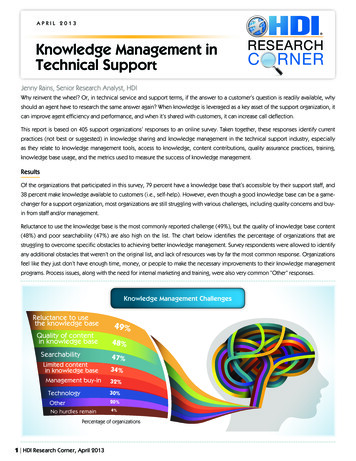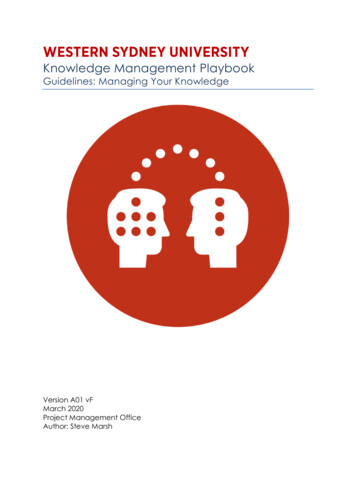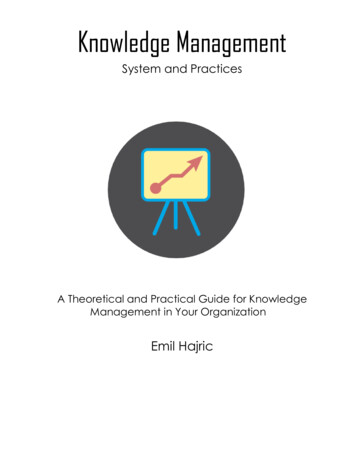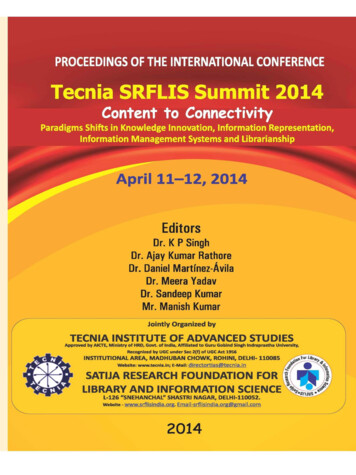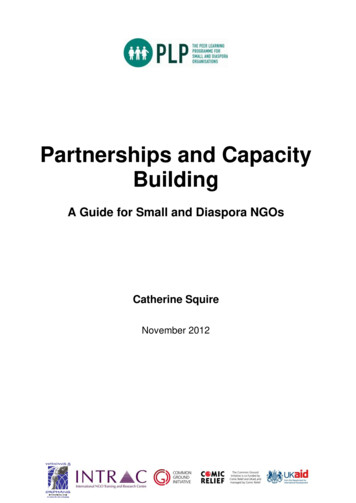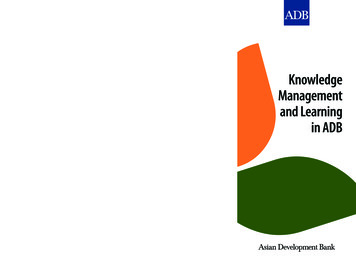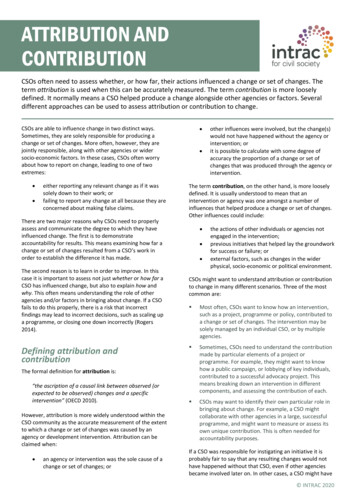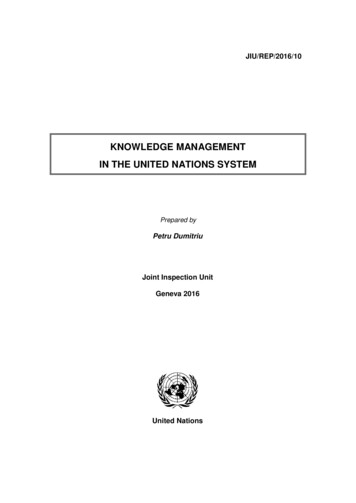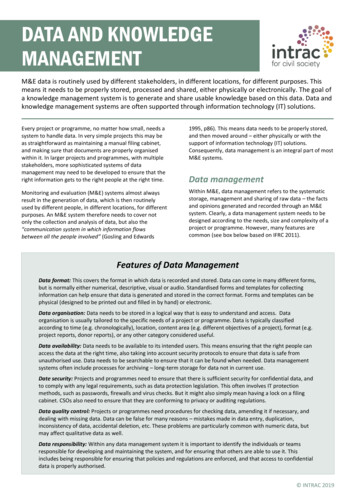
Transcription
DATA AND KNOWLEDGEMANAGEMENTM&E data is routinely used by different stakeholders, in different locations, for different purposes. Thismeans it needs to be properly stored, processed and shared, either physically or electronically. The goal ofa knowledge management system is to generate and share usable knowledge based on this data. Data andknowledge management systems are often supported through information technology (IT) solutions.Every project or programme, no matter how small, needs asystem to handle data. In very simple projects this may beas straightforward as maintaining a manual filing cabinet,and making sure that documents are properly organisedwithin it. In larger projects and programmes, with multiplestakeholders, more sophisticated systems of datamanagement may need to be developed to ensure that theright information gets to the right people at the right time.1995, p86). This means data needs to be properly stored,and then moved around – either physically or with thesupport of information technology (IT) solutions.Consequently, data management is an integral part of mostM&E systems.Monitoring and evaluation (M&E) systems almost alwaysresult in the generation of data, which is then routinelyused by different people, in different locations, for differentpurposes. An M&E system therefore needs to cover notonly the collection and analysis of data, but also the“communication system in which information flowsbetween all the people involved” (Gosling and EdwardsWithin M&E, data management refers to the systematicstorage, management and sharing of raw data – the factsand opinions generated and recorded through an M&Esystem. Clearly, a data management system needs to bedesigned according to the needs, size and complexity of aproject or programme. However, many features arecommon (see box below based on IFRC 2011).Data managementFeatures of Data ManagementData format: This covers the format in which data is recorded and stored. Data can come in many different forms,but is normally either numerical, descriptive, visual or audio. Standardised forms and templates for collectinginformation can help ensure that data is generated and stored in the correct format. Forms and templates can bephysical (designed to be printed out and filled in by hand) or electronic.Data organisation: Data needs to be stored in a logical way that is easy to understand and access. Dataorganisation is usually tailored to the specific needs of a project or programme. Data is typically classifiedaccording to time (e.g. chronologically), location, content area (e.g. different objectives of a project), format (e.g.project reports, donor reports), or any other category considered useful.Data availability: Data needs to be available to its intended users. This means ensuring that the right people canaccess the data at the right time, also taking into account security protocols to ensure that data is safe fromunauthorised use. Data needs to be searchable to ensure that it can be found when needed. Data managementsystems often include processes for archiving – long-term storage for data not in current use.Date security: Projects and programmes need to ensure that there is sufficient security for confidential data, andto comply with any legal requirements, such as data protection legislation. This often involves IT protectionmethods, such as passwords, firewalls and virus checks. But it might also simply mean having a lock on a filingcabinet. CSOs also need to ensure that they are conforming to privacy or auditing regulations.Data quality control: Projects or programmes need procedures for checking data, amending it if necessary, anddealing with missing data. Data can be false for many reasons – mistakes made in data entry, duplication,inconsistency of data, accidental deletion, etc. These problems are particularly common with numeric data, butmay affect qualitative data as well.Data responsibility: Within any data management system it is important to identify the individuals or teamsresponsible for developing and maintaining the system, and for ensuring that others are able to use it. Thisincludes being responsible for ensuring that policies and regulations are enforced, and that access to confidentialdata is properly authorised. INTRAC 2019
It is important to recognise that a data managementsystem designed to support M&E is rarely developed inisolation. It is usually part of a wider data managementsystem, and therefore needs to fit in with widerorganisational policies and requirements. This means thatM&E staff, or staff engaged in M&E activities, may need toliaise with other internal actors, such as IT support staff. Whilst data management often goes beyond M&E, thereare times when the requirements of an M&E system meritspecial considerations. Some examples of this are describedbelow.Knowledge management Many M&E methodologies require the development ofbaselines, or baseline surveys. Several years mayelapse between a baseline and a follow-up datacollection exercise. Sometimes the follow-up isconducted by a different agency. For example, abaseline survey is often done by internal project staff,and a repeat survey is later done by externalevaluators. It is therefore vital to ensure that proper,detailed records are kept of the original baseline. Thismay include details of who was interviewed, along withtheir names, addresses and access details.Some methodologies for data collection and analysis(e.g. Outcome Mapping, outcome harvesting, the mostsignificant change (MSC) technique) are data intensive,and result in a large amount of qualitative data beingcollected over time. It is important to design dedicateddata management processes to ensure that all thisdata is stored properly, and can be accessed andanalysed when needed.Other methodologies, such as qualitative comparativeanalysis (QCA), social network analysis, quasiexperimental trials or randomised control trials,require data to be stored or processed in very specificways, often in dedicated databases or spreadsheets.Many CSOs produce photographs, recorded audiomaterials, videos, and other kinds of audio-visualmedia. These need to be properly stored, along withassociated data (e.g. dates, locations, permissions foruse). The same is true for narratives such as casestudies, stories of change and testimonials.Participatory M&E methods are designed to involvesupported communities throughout monitoring andevaluation processes. In these circumstances it isimportant to ensure that any data generated is storedin a way that is useful to those communities, or toensure that they are able to store and access their owndata in their own way.Most CSOs generate large amounts of qualitative data,which can be difficult to process and analyse.Qualitative data management often involves sortinginformation according to different categories,groupings or themes, such as evaluation questions,objectives or indicators. Without this, it can beimpossible to retrieve and analyse qualitativeinformation after it has been used for its immediatepurpose.Most larger CSOs suffer in one form or another fromthe evaluation graveyard syndrome, where old reports,reviews and evaluations sit gathering dust on shelves.This is often because they have not been incorporatedinto a data management system that allows theinformation within them to be easily accessible.Data management is a necessary feature of most M&Esystems. But it is not sufficient on its own, especially inlarger projects and programmes. Knowledge managementgoes further than data management, and can be defined asthe “systematic processes by which the knowledge requiredby an organisation is created, captured, refined, stored,accessed, shared and used” (Britton 2005, p8).Knowledge management is based on an assumption thatdata management is not an end in itself, but should insteadbe seen as a way of enabling organisational goals to beachieved. The goal of knowledge management is to enableorganisations to acquire or create useful knowledge, andthen make it available to those who can use it at anappropriate time and place (King 2009). So while datamanagement simply looks at how raw data is collected,stored and accessed, knowledge management goes furtherto generate usable knowledge based on this data.A useful way of looking at this is to see data (orinformation) as raw facts and opinions, knowledge asprocessed and/or analysed data, and wisdom as the desiredend product (see box below, based on Britton (2005)).Information, Knowledge and WisdomInformation(or data)Information includes raw facts and opinions.It can be developed through formalprocesses, carried out as part of monitoring,evaluation, impact assessment or researchexercises. But it can also be generatedthrough informal processes.KnowledgeWhen information is systematically organisedthrough storage, processing and analysis itturns into knowledge. This knowledge can beused to answer questions and drawconclusions.WisdomWisdom is a process that involves combiningknowledge with experience, understanding,common sense and insight to guide actionand make decisions.A common model used to support knowledge managementis the people, process and technology model. This modelidentifies three main elements for successful knowledgemanagement:1.connecting people who have the knowledge tohelp each other, and developing their willingnessand ability to ask, share and listen; INTRAC 2019
2.3.developing processes to simplify the sharing,validation and distillation of knowledge; anddeveloping reliable, user-friendly technology tofacilitate communication.In smaller projects there may not be much need to invest inprocesses and technology. But as developmentinterventions progress from smaller to larger projects, andthen to programmes and organisations, things get morecomplicated, and it becomes necessary to rely more onprocesses and technology for sharing knowledge, and lesson personal contacts and relationships.However, there is a danger that CSOs become too focusedon data management, and thereby lose sight of its purpose.In the early 2000’s many larger NGOs developedcomprehensive data management systems, but foundthese only delivered benefits if there was a sufficient focuson people (see case study opposite). Processes andtechnologies need to be planned and developed to servethe people who use them, and not the other way around.Key elements of knowledgemanagementAs with data management, knowledge management cancover a number of different aspects. Some of these arecontained in the table below (based on Britton 2005, King2009). However, the precise methods used will inevitablyvary from CSO to CSO according to need. There is no ‘oneCase study: Knowledge sharing in ConcernIn around 2008, the information technology (IT) department inConcern took the lead in developing its approach to knowledgemanagement (KM). The result was a technology-centric version ofKM. Databases capable of capturing lessons learned were created,with the assumption that staff would use them to improve theirpractice. For example, a knowledge repository was created whichhoused over 4,000 documents.Unfortunately, the technology-heavy solution did not yieldpositive results. This was partly because many staff did not knowhow to upload content onto the platform being used - MicrosoftSharePoint. In addition, for field offices to use the databases theyneeded to be connected to Concern’s intranet. Limitedconnectivity, a lack of stakeholder buy-in, and access challenges,combined with a level of technophobia, all united to underminethe system.These issues led to a change in focus for Concern in 2011. A newnewsletter was introduced, centring on connecting people whohad knowledge and wanted to share it, as opposed to simplycompiling knowledge in databases. In its initial stages the resultsof this renewed effort were impressive, and were consideredmuch more valuable to the organisation.Source: Matturi, 2014size fits all’ method, because each organisation hasdifferent needs and objectives, and each requires a tailoredknowledge management approach.Elements of Knowledge ManagementKnowledge creation happens whenever new data is created; for example when information is recorded on atemplate or form, or opinions of staff are written down. But it can also happen when people combine informationand/or existing knowledge in new ways to create new knowledge. For example, CSO staff might generate newknowledge through sharing experiences at a meeting or workshop.Knowledge capture is about identifying and/or recording knowledge from within or outside an organisation. Thiscould include explicit knowledge in the form of printed documents or information held on databases. But it couldalso include implicit knowledge. This is the knowledge held by CSO staff, or by teams working on specific issues.Implicit knowledge may also be embedded in a CSO’s products, processes and relationships.Knowledge access happens when a CSO looks for, and acquires, knowledge from a specific source. This couldinclude knowledge based on an individual staff member’s experiences, or those of colleagues. But it could alsoinclude knowledge from documentation (including policies, procedures, guidelines, standards or academicpublications) or the experiences of staff from other organisations. Knowledge could also be accessed fromcommunities of practice, external experts, networks, or events (such as conferences or workshops).Knowledge storage is linked to data management, and often uses the same technologies and processes. But itmay go further than the storage of raw data and opinions, and may involve the capture of lessons learned, orother kinds of processed and analysed information.Knowledge sharing is about making knowledge available to others. For knowledge to have wider organisationaluse it must be transferred or shared. Transfer can be defined as focused and purposeful communication to aknown receiver, whilst sharing normally means disseminating knowledge more widely.Knowledge use involves using knowledge for specific purposes. This, of course, is the ultimate goal of knowledgecreation, capture, access, storage and sharing. As far as M&E is concerned, purposes might include learning,accountability, project/programme management, providing evidence for advocacy work, enhancingcommunications, fundraising and marketing, amongst many others. INTRAC 2019
Databasesproblems with poor internet connectivity when peopleare working in the field. In addition, many staffnowadays are familiar with the software, whichreduces the need for training or IT assistance. Thedownside – especially if large amounts of data aregenerated in multiple locations – is that it can bedifficult to manage and coordinate data, particularly ifdata is loaded onto multiple Excel or Access sheets ondifferent computers and then sent to staff centrally forcleaning and consolidation.CSOs often store M&E data in databases. Smaller projects,programmes and organisations may not need to developelectronic databases, but ones generating large volumes ofdata often do. Sometimes, M&E information can be addedto existing organisational databases, or other forms of ITplatform, and sometimes databases need to be speciallydesigned for the purpose.The added-value of a database lies mostly in its ability toorganise and combine information from multiple sources,and share it with different stakeholders in differentlocations. But when deciding what sort of database todevelop, the benefits need to be carefully balanced againstthe costs. These include the costs of computers andsoftware, the time taken for staff to enter data, inductionor training requirements, and the costs of maintaining thedatabase. If a CSO already has a database then the financialcosts of adding M&E information may be small. Another option is to use ‘off-the-shelf’ software. This isusually software designed to manage project resultsdata (such as district health information) that can becustomised by a CSO. It is usually cheaper to buy thiskind of software then to develop a bespoke system.However, it may be difficult to adapt it to a CSO’sparticular needs. Some CSOs pay an IT company to produce a custommade database. This has the obvious advantage that itcan be produced to meet all of a CSO’s requirements.However, additional costs are often incurred if theserequirements change, and IT support may be neededon a regular basis. In addition, it can take a long timefor databases to be developed, and they may be veryexpensive.IT systems, such as databases, can perform a number ofbasic functions for M&E. For example: basic records – such as names, addresses,telephone numbers – can be stored, allowing staffto easily contact different stakeholders;documents such as plans and reports can beattached for easy retrieval when needed;many databases hold bespoke M&E informationsuch as objectives, indicators, targets, plannedactivities, etc., along with associatedachievements;databases can allow the latest versions of formsand templates to be downloaded or completedonline;some databases allow for the automaticprocessing of statistical information, e.g. adding upnumbers from different locations;many databases allow information to be searched,through the use of word searches, or tagging usingkeywords; anddatabases often allow data to be coded or sortedin different ways – for example, reports of changecould be coded according to the relevant objectiveor indicator.In some cases, databases may be designed to enable notonly data management, but also wider aspects ofknowledge management. For example, databases may bedesigned to enable staff within an organisation to inputcomments, suggestions, ideas and lessons learned so thatothers may access and use them. In this way, a databasecan support the wider use of information – helping totranslate data / information into knowledge, and then intowisdom.There are three main options for developing a database(see Levine et. al. 2016). The first is to use existing (usually Microsoft) softwaresuch as Excel or Access to develop a customiseddatabase. The big advantage of this is that the softwareis often already on staff computers, thus avoidingThe three options above are the main options for CSOswishing to cover the full spectrum of their work. But if aCSO is only looking to support an individual project orprogramme then other options can be applied. Forexample, different statistical packages, such as theStatistical Packages for the Social Sciences (SPSS), can beused to stored and process large amounts of numericaldata from an individual project. Similarly, a variety ofsoftware packages have been produced than can be usedto help with qualitative data analysis. These products tendto be used more on a project-by-project basis.Common challenges with databasesA well-designed and maintained database can help supportCSOs’ M&E systems immensely. However, there are manypotential challenges that need to be clearly understood atthe outset. Some of these are described below. Databases usually need to be supported by dedicatedIT staff, either within or outside an organisation. It isvital that M&E and IT staff work together, and incollaboration with the field staff responsible for datacollection. IT staff may not understand the needs of anM&E system, or may not appreciate that not allprocesses can be automated. Information duplication is often a significant problem.Many CSOs end up entering data manually more thanonce, especially CSOs with multiple departments, suchas M&E, fundraising and communicationsdepartments. A recent study by ITAD (2014) revealedthat most NGOs duplicate data to some degree orother, and end up storing the same data in differentforms. INTRAC 2019
The same study suggests that CSOs find it much easierto design databases to store and analyse quantitativedata. This means that qualitative information (orindeed any information reflecting unanticipatedchange) is often missed out. INTRAC has seen manyexamples of IT systems that are only capable ofhandling quantitative indicators and targets, and donot allow staff to process qualitative indicators, orreflect lessons learned.A critical factor is how far a database is designed withthe capacities and realities of the staff collecting andusing the data in mind. Any database needs to be userfriendly and accessible. If it is not, people will eithernot use it, or they will be careless when entering data.If a system or database saves them time and effortthey are much more likely to use and appreciate it.If a CSO is not careful, a database can lead to theprioritisation of explicit knowledge (facts, numbers,reports) to the exclusion of staff’s implicit knowledge,such as insights, intuitions and experiences. Capturingthis kind of knowledge is much more difficult, but it isoften just as important for decision-making.It can be very difficult to get people to enterinformation onto a database unless data entry iscompulsory and enforced (as it is in a financialmanagement system). It is very hard, for instance, toget people to enter lessons learned onto a databaseunless they feel it will benefit them, and unless it ismade easy for them. Most people in the social development worldappreciate that power and knowledge are related.There is a risk that reliance on technology can lead to acommodification of knowledge, because the peoplethat have access to the knowledge contained within adatabase have greater power than those that do not.For CSOs that strongly believe in helping to empowercommunities, the central management of data andinformation can be a concern.Whichever option is chosen, the fundamental issue stillremains. A database can help a CSO capture, store, retrieveand process M&E information to a certain extent. It canthereby help translate raw data / information into usableknowledge. But using that knowledge – and translating itinto organisational wisdom – requires human interaction.“People will share knowledgethrough workshops; they willlearn together. Butencouraging people todocument is a Herculeantask” Wakwabubi (2011)Further reading and resourcesDifferent sections of the M&E Universe focus on three key topics of knowledge management: data collection, data analysis anddata use. These papers contain further guidance on how to collect, generate, share and use knowledge within an M&E system.Another paper in this section of the M&E Universe deals with the supporting environment for M&E systems. Separate papersdeal with project and complex M&E systems.Project M&E systemsOverview of complex M&E systemsThe supporting environment for M&EData collectionData analysisData useThe paper by Bruce Britton (2005) referenced below is a good starting point for people wishing to know more about knowledgemanagement in CSOs, and how it can be used to support organisational learning. It is available from INTRAC’s website onal-learning-in-ngos-bruce-britton/In 2006, the Overseas Development Institute (ODI) produced a document called “Tools for Knowledge and Learning: A Guide forDevelopment and Humanitarian Organisations”, by Ben Ramalingan. It contains many practical examples of tools used toenhance knowledge management and organisational learning. It can be downloaded from the ODI website ssets/publications-opinion-files/188.pdfThe IFRC guide to M&E, referenced below, contains a long section on data management. This is based on a longer piece of workby Rodolfo Siles, called “Project Management Information Systems”. This was written in 2004. INTRAC 2019
References Britton, B (2005). Organisational Learning in NGOs: Creating the Motive, Means and Opportunity. Praxis Paper No.3. INTRAC,March 2005. Gosling, L and Edwards, M (1995). Toolkits: A Practical Guide to Assessment, Monitoring, Review and Evaluation. Save theChildren Development, Manual No.5, London. IFRC (2011). Project/programme Monitoring and Evaluation (M&E) Guide. International Federation of Red Cross and RedCrescent Societies. Geneva, 2011. ITAD (2014). Investing in Monitoring, Evaluation and Learning: Issues for NGOs to consider. ITAD, in association with NEFConsulting. Edited by Jennifer Chapman, March 2014. King, W (2009). Knowledge Management and Organizational Learning. Omega. 36. pp167–172. Levine, C; van Vijfeijken, T and Jayawickrama, S (2016). Measuring International NGO Agency-Level Results. InterAction, May2016. Matturi, K (2014). Knowledge sharing in action: The case of Concern Worldwide’s Knowledge Matters. Praxis Note, No. 68.INTRAC, Oxford, UK. Wakwabubi, E (2011). Comments ascribed to senior Kenyan development practitioner, quoted in Matturi (2014).Author(s):Nigel SimisterINTRAC is a specialist capacity building institution for organisations involved in international reliefand development. Since 1992, INTRAC has contributed significantly to the body of knowledge onmonitoring and evaluation. Our approach to M&E is practical and founded on core principles. Weencourage appropriate M&E, based on understanding what works in different contexts, and we workwith people to develop their own M&E approaches and tools, based on their needs.INTRAC TrainingM&E Training & ConsultancyWe support skills development and learning on a range ofINTRAC’steam ofhighM&Especialistsoffer consultancyandthemes throughqualityand mcoreskillsdevelopmentonline and tailor-made training and coaching.through to the design of complex M&E systems.Email: training@intrac.orgTel: 44 (0)1865 201851Email: info@intrac.orgTel: 44 (0)1865 201851M&E UniverseM&E UniverseFor more papers inForinthemoreM&EpapersUniversethe seriesM&E Universeclick theseriesthehomeclickbuttonhome button INTRAC 2019
template or form, or opinions of staff are written down. But it can also happen when people combine information and/or existing knowledge in new ways to create new knowledge. For example, CSO staff might generate new knowledge through sharing experiences at a meeting or workshop. Knowledge capture
